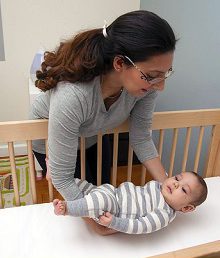Parents and Caregivers
Creating a Safe Sleep Area for Babies
Health care providers and researchers don’t know the exact causes of sudden infant death syndrome (SIDS). However, research shows parents and caregivers can help reduce the risk of SIDS and other sleep-related infant deaths by doing the following:

- Place your baby on his or her back for all sleep times—naps and at night.
- Use a firm, flat (not at an angle or inclined) sleep surface, such as a mattress in a safety-approved crib, covered by a fitted sheet.
- Keep your baby’s sleep area (for example, a crib or bassinet) in the same room where you sleep, ideally until your baby is at least 6 months old.
- Keep soft bedding such as blankets, pillows, bumper pads, and soft toys out of your baby’s sleep area.
- Do not cover your baby’s head or allow your baby to get too hot. Signs your baby may be getting too hot include sweating or his or her chest feels hot.
View a safe sleep environment at What does a safe sleep environment look like? from Safe to Sleep®.
Additional Recommendations to Reduce the Risk of SIDS
CDC supports the 2022 recommendations issued by the American Academy of Pediatrics (AAP).
In addition to the recommendations listed above, other recommendations from the AAP to reduce the risk of SIDS include:
- Do not smoke or use nicotine during pregnancy, and do not smoke or allow smoking around your baby. For help quitting, see How to Quit Smoking.
- Do not drink alcohol or use illegal drugs during pregnancy.
- Feed your baby breastmilk. Find out more about breastfeeding your baby to reduce the risk of SIDS [PDF – 480 KB].
- Visit your baby’s health care provider for regular checkups. Your baby will receive important shots to prevent disease.
- Offer your baby a pacifier at nap time and bedtime. If you are breastfeeding your baby, you may want to wait to use a pacifier until breastfeeding is well-established.
Parents and caregivers can learn more about these and other recommendations at Ways to Reduce Baby’s Risk from Safe to Sleep® and How to Keep Your Sleeping Baby Safe: AAP Policy Explained from AAP’s Healthy Children website.
CDC Safe Sleep Video
In 2019, CDC hosted a Facebook live event to communicate information about safe sleep for babies during SIDS Awareness Month. To support organizations in developing their own remote, live social media events to promote safe sleep, CDC developed a toolkit with additional resources.
NICHD Spanish-language Safe Sleep Video
Learn about how to create a safe sleep environment for baby and find out answers to frequently asked questions this Spanish-language video featuring experts from the Eunice Kennedy Shriver National Institute of Child Health and Human Development (NICHD) and CDC.
Safe Sleep Resources
Safe to Sleep®
CDC collaborates with the Eunice Kennedy Shriver National Institute of Child Health and Human Development in its Safe to Sleep® campaign, formerly known as the Back to Sleep campaign. The Safe to Sleep® campaign has outreach activities to spread safe sleep messages and educational materials about ways to reduce the risk of SIDS and other sleep-related infant deaths.
Cribs for Kids®
Cribs for Kids® works to prevent infant sleep-related deaths by educating parents and caregivers on the importance of practicing safe sleep for their babies through programs (such as the Safe Sleep Ambassador program) and by providing portable cribs to families who, otherwise, cannot afford a safe place for their babies to sleep.
Safe Kids Worldwide
Find sleep safety and suffocation prevention tips from Safe Kids Worldwide, a nonprofit organization working to help families and communities keep kids safe from injuries.